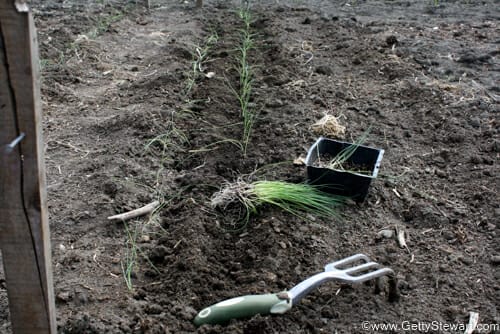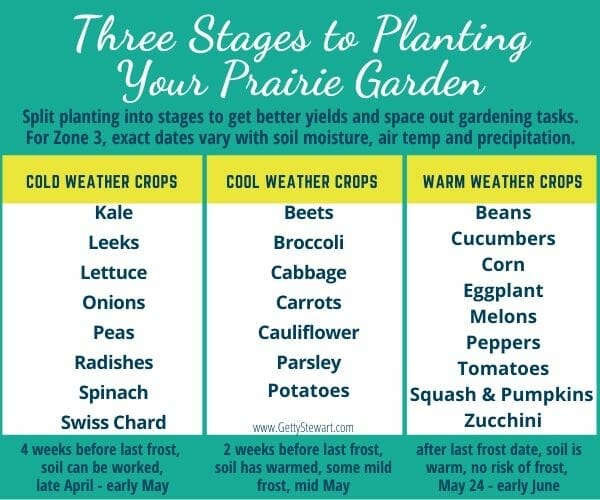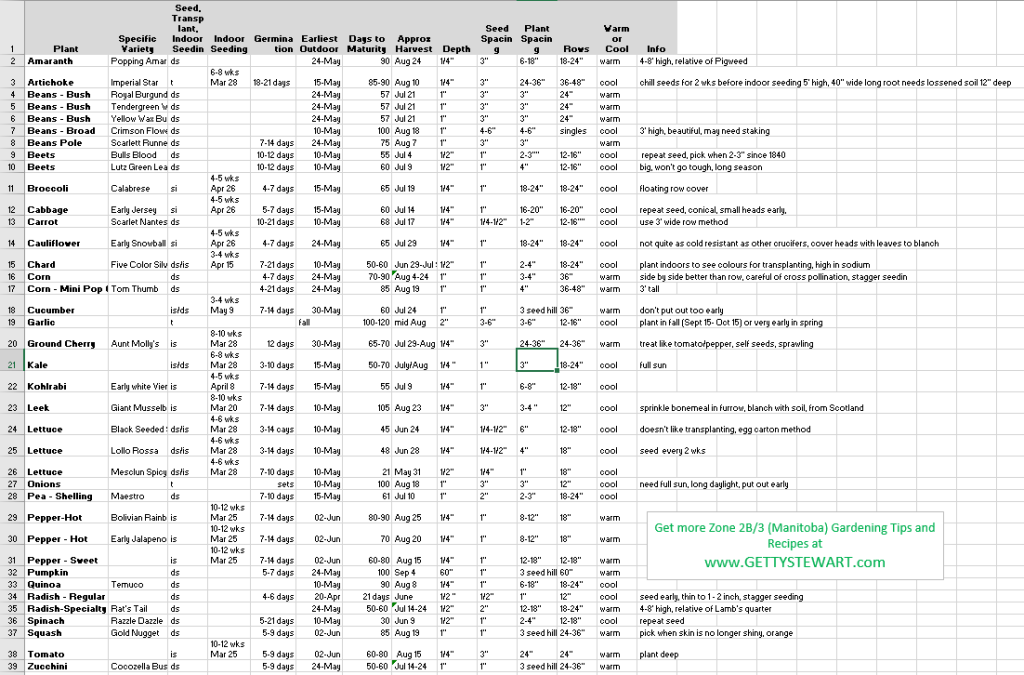When to Plant Your Garden in Manitoba
When to plant your garden is a common question among gardeners. May long weekend has always been significant to Canadian prairie gardeners in Zone 3 – it’s our average last frost date and it’s definitely a great time to be in the garden. But, it’s not necessarily the best time for all plants and seeds to go into the ground. Plus, soil, moisture and air temperature are different every year and may change our planting plans significantly.

Also Read: When to Start Seeds Indoors, When to Start/Plant Herbs, Making a Gardening Plan
Figure Out Your Gardening Zone: Canada’s Plant Hardiness Zones, US Plant Hardiness Zones
Figuring Out Your First Frost Free Date: Farmer’s Almanac’s First and Last Frost Days by Postal & Zip Code
If you’ve had less than stellar success growing some plants, are wondering why your fellow gardeners are enjoying a bounty of peas much earlier than you or why your onions don’t seem to get any larger than a golf ball – planting time may be something to consider.
When to Plant Your Garden
How to decide when to plant what in your garden is a mix of science, art and gut feeling. Science tells us the ideal time and temp for seed germination. Weather forecasts, history and gut feeling lead to the final decision as to when to put the seed or transplants in the ground. It varies from one year to the next, but there are general trends. Over the years, I’ve narrowed my planting down to three stages based cold tolerance and preferences of plants. Some plants like kale and spinach simply do better in cool temps, others like tomatoes and squash hate the cold. Planting according to their preference results in better yields and spreads out garden tasks to be more manageable. Of course, I always adjust for yearly conditions, but generally speaking I plant in three major groupings based on cold, cool and warm loving plants.

Cold Weather Crops
Plant outdoors 4 weeks before last frost or as soon as the soil can be worked after the snow is gone. In a good year, in Winnipeg, this can be as early as April 26. But the soil needs to be workable (see below). Working damp soil can compact it and cause other issues later.
Cool Weather Crops
Plant outdoors 2 weeks before last frost (in Winnipeg – May 15)
Warm Weather Crops
Plant after the last frost when soil is warm and air temperature is consistently above 10°C/50°F (in Winnipeg – May 24 to June 2)
How to Plant Vegetables in the Garden – Spacing and Depth
Here’s my personal planting chart for the veggies I grow. To see it enlarged, right click and open image in a new tab.

More Ways to Determine When to Plant Your Garden
And here are some more in depth approaches to consider for when to plant what.
The Soil Temperature Approach
Here’s a handy soil temperature guide for various vegetable crops from the Weekend Gardener.
To use this approach consider purchasing a soil thermometer ($9.50 at Lee Valley).
| Soil Temperature Guidelines for Vegetable Crops | |
| Crops that will germinate in the coolest soils, down to 4° C | arugula, fava beans, kale, lettuce, bok choi, parsnips, peas, radicchio, radish and spinach seed |
| Crops that will germinate with a soil temperature above 10° | Chinese cabbage, leeks, onions, Swiss chard, and turnips |
| Crops that will germinate with a soil temperature at or above 16° C | beans, beets, broccoli, Brussels sprouts, cabbage, carrots and cauliflower.NOTE: Beans will not tolerate any frost and may have to be planted again if the temperature goes below freezing |
| Crops that will germinate with a soil temperature above 21° C | tomatoes, eggplants, peppers, cucumbers, squash, corn and melons.NOTE: Tomatoes, eggplants and peppers are slow-growing and take many weeks to grow to the stage where you can plant them out in the garden, so you might want to purchase these seedlings from your local garden center. On the other hand, squash, cucumbers and corn grow quickly and are easier to start from seed |
The Soil Clumping Approach
Here’s some advice from The Old Farmer’s Almanac about testing the soil with your hands.
- Grab a handful of your garden soil. If you can form it into a ball, the soil is too wet for planting. (Chances are the seeds will rot.) If it crumbles through your fingers, it’s ready for planting.
- Here’s another soil test. Make a ball of soil and drop it. If the ball crumbles, your garden is ready for seeds. If it holds its shape or breaks into two clumps, it’s still too wet for planting.
- You can also step into the garden and then step back and look at the footprint you’ve left in the soil. If it’s shiny, then there’s too much water near the soil’s surface to dig and plant. If it’s dull, then excess water has drained away and it’s time to plant.
- Old farmers had an even easier guideline: When the weeds start to grow in your garden, it’s time to plant your hardy vegetables
The Phenology Approach
This approach is interesting and requires a keen sense of observation. Basically, it’s using cues from nature to identify when to plant certain things. For example, here’s a list from About.com Gardening :
| Plant peas | When forsythia & daffodils blooms |
| Plant potatoes | When 1st dandelion blooms |
| Plant beets, carrots, cole crops, lettuce and spinach | When lilac is in first leaf |
| Plant beans, cucs and squash | When lilac is in full bloom |
| Plant tomatoes | When lily-of-the-valley are in full bloom |
| Transplant eggplant, melon and peppers | When irises bloom |
| Plant corn | When apple blossoms start to fall |
The Mom Approach
Of course we can’t forget the old “my mom said so” approach. It’s only natural that we take into consideration what our foremothers did. So, if mom always seeded carrots on May 15 and she always had a bumper crop – well, there must be something to it. Why mess with success.
Whatever approach you choose, I have found keeping a log (or a blog) is very beneficial. It’s great to go back and see what worked and what didn’t and then go from there.
When you are ready to start planting your veggies check out these posts:
How to Plant Various Vegetables
Happy Gardening!
Please, do me a favor. If you like this post, find the information useful and want to help me be able to provide more helpful tips and recipes, please comment below or share this post on social media. You can reach me on instagram @getgettys or Facebook @GettyStewart.HomeEconomist.


Hi Getty,
Came across your page when trying to find some information. Very helpful info. My boyfriend and I were just wondering if its is too late to plant parsley, dill, spinach, green onion, sweet basil, garlic and lettuce this year. Is there still any chance for any of them or will it have to wait for next year? Thanks so much.
Kira,
Hi Kira,
Good news, it’s not too late! I think the only one that you might not have much luck with is garlic. I’d save your garlic and plant it this fall (http://www.gettystewart.com/how-to-plant-garlic/). If you plant it now, you might still get some cloves, but they’ll be very small. Spinach and lettuce grow quite quickly and often people will seed several crops per season, so you’re good to go. Just be aware that they don’t do well in super hot conditions, they’ll bolt (grow seed stalks) very quickly. Hope that helps!
Getty
This is an amazing guide!!! Thank you!!! I live close to Brandon and wondering when you would suggest planting sugar baby watermelons and if you would start them indoors? As well what are your thoughts on herbs such as basil, oregano, parsley and thyme?
Hi Laura,
So glad you found the information useful. Us prairie gardeners have to stick together and share info that’s relevant to our growing conditions.
As for the baby watermelons, watermelons produce best results with plenty of sun, warmth and consistent watering. Give them a head start by starting seeds indoors, but don’t transplant them until the soil is nice and warm and there’s no risk of frost – around June 1.
Check out this herb chart I just posted for a general overview of herbs http://www.gettystewart.com/herb-growing-chart-for-prairie-gardens/.
Basil, oregano, parsley and thyme are all herbs you can start quite easily indoors – right now! Parsley can take a while to germinate so don’t be alarmed if it doesn’t come up as quickly as the others. Try different varieties of basil – lemon basil (great for tea), red rubin (great for salad dressings), thai basil (thai cooking), and the classic sweet basil/genovese (all things tomato). If you want fuller, more established plants right away consider buying thyme and oregano plants from a greenhouse, but they’re both pretty quick growing and will typically return once well established. For the most intense, classic flavored oregano look for Greek oregano. I love all kinds of thyme too – there’s the classic one for most savory recipes, but lemon thyme is awesome for chicken, veggies, fish, pasta and for herbal teas too.
Have fun and keep me posted on your progress.
Getty
What great advise!! Thank you so much for posting this!! I’m still a novice gardener and need all the help I can get!
Thanks Heather, I’m glad you found it useful. Good luck with your garden!
Getty you are my planting guide guru, the onions, garlic and some chard are going in this week for my CSA.
Aw, thanks Nancy! Wish you all the best with your CSA!
When is the best time to transplant strawberry runners in Manitoba ?
Hi Jeanette
Good question, I’m not sure about that. I do see that my strawberries are eager to transplant themselves right now – they’re staking out new territory. Colleen Edmunds at Grunthal Berries might be able to help. Did you know that they’re picking fall strawberries right now! Look for Grunthal Berries on Facebook.
Hi Stewart
I am just getting back into gardening after a 3 year hiatus. I am planting my garden this weekend and am curious to know if there are certain vegetable plants that can be grown together to offer protection from the bugs and insects? I do know there are some flowers that offer this kind of protection such as marigolds. Just curious and thought I would ask:) Thank you for your time.
Penny
Hi Penny,
Sorry for the delay, your message got buried in the spam folder. Marigolds are a great companion for most things. Onions and carrots go well together – the onions keep the carrot flies away. Do you have a particular plant that you’re growing that you’re concerned about – or a particular pest? By now I’m sure you have your garden planted. Good luck!